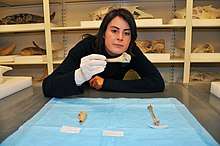Camilla Speller
Camilla F. Speller is a biomolecular archaeologist, Assistant Professor in Anthropological Archaeology at the University of British Columbia Department of Anthropology.
Camilla Speller | |
|---|---|
 | |
| Nationality | Canadian |
| Occupation | Professor of Anthropological Archaeology |
| Awards | Philip Leverhulme Prize 2016 |
| Academic background | |
| Education | University of Calgary PhD., Simon Fraser University |
| Thesis | Investigating turkey (Meleagris gallopavo) domestication in the Southwest United States through ancient DNA analysis (2009) |
| Academic work | |
| Discipline | Anthropology |
| Sub-discipline | Archaeology |
| Institutions | University of British Columbia, University of York, University of Calgary |
Education
Speller obtained her BA from the University of Calgary with a double major in archaeology and biological anthropology. She completed her MA at Simon Fraser University in 2005, using aDNA analysis to examine the distribution of salmon species at the Northwest Plateau site of Keatley Creek in British Columbia Canada. She completed her PhD, completed at Simon Fraser in 2009[1] with a dissertation that applied ancient DNA techniques to study the human use of wild and domestic turkeys in the Southwest United States[2]
Career and research
In 2010 Speller was awarded a SSHRC postdoctoral fellowship at the University of Calgary to continue her research on North American turkey domestication. In 2012 she was awarded a Marie Curie Fellowship to train at the University of York BioArCh Centre. During this time she applied ZooMS and ancient DNA analysis to address questions concerning historic whale exploitation[3]. She was appointed as a Lecturer in Archaeology at the University of York in 2014[4] where she led the ancient genetics group at BioArCh until 2018, when she moved to the Department of Anthropology at UBC.
Speller applies biomolecular techniques to address questions related to human-environment relationships in the past and present, ancient diets[5], and how humans have shaped their physical environment, from broad ecosystem impacts to the micro-environment of the human body, including ancient microbiomes.[6] She uses ancient DNA analysis, ancient proteins and collagen peptide mass fingerprinting (ZooMS).
Prizes and awards
Speller was the recipient of a Philip Leverhulme Prize in Archaeology in 2016,[7][8] and in 2010 was awarded the Gold Governor General's Academic Medal for her PhD dissertation on North American Turkey domestication.[9]
Selected publications
Hendy J, Warinner C, Bouwman A, Collins MJ, Fiddyment S, Fischer R, Hagan R, Hofman CA, Holst M, Chaves E, Klaus L, Larson G, Mackie M, McGrath K, Mundorff AZ, Radini A, Rao H,Trachsel C, Velsko IM, Speller CF (2018) Proteomic evidence of dietary sources in ancient dental calculus, Proceedings of the Royal Society B, 20180977
Hendy J, Welker F, Demarchi B, Speller C, Warinner C, Collins MJ (2018) A Guide to Ancient Proteins, Nature Ecology and Evolution, 2, 791–799.
Mackie M, Hendy J, Lowe A, Sperduti A, Holst M, Collins MJ, Speller C (2017) Preservation of the metaproteome: Variability of protein preservation in ancient dental calculus, STAR: Science & Technology of Archaeological Research 3(1), 74–86. doi: 10.1080/20548923.2017.1361629
Green EJ, Speller CF (2017) Novel substrates as sources of ancient DNA: prospects and hurdles, Genes, 8(7), 180; doi:10.3390/genes8070180
Speller C, ven den Hurk Y, Charperntiere A, Rodrigues A, Gardeisen A, Wilkens B, McGrath K, Rowsell K, Spindler L, Collins M, Hofreiter M (2016) Barcoding the largest animals on earth: on-going challenges and molecular solutions in the taxonomic identification of ancient cetaceans, Philosophical Transactions of the Royal Society B, 371: 20150332
Speller CF, Hauser L, Lepofsky D, Moore J, Rodrigues AT, Moss M, McKechnie I, Yang DY (2012) High Potential for Using DNA from Ancient Herring Bones to Inform Modern Fisheries Management and Conservation”. PLoS One 7(11):e51122.
References
- "PhD Dissertations: Camilla Speller, 2009 Investigating Turkey Domestication in the Southwest United States Through Ancient DNA Analysis". Simon Fraser University.
- "Camilla Speller". UBC Department of Anthropology.
- "Optimizing Research tools for Cetaceans in Archaeology". European Commission.
- "ORCiD Camilla Speller". ORCiD.
- "Ancient Plaque Hints at British Diets Over Time". Archaeology Magazine.
- "A plaque on both your houses: exploring the history of urbanisation and infectious diseases through the study of archaeological dental tartar". Wellcome Trust.
- "York archaeologist awarded major funding prize". University of York.
- "Philip Leverhulme Prizes 2016". Leverhulme Trust.
- "2010 Convocation medal roundup". Simon Fraser University.